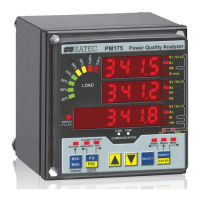and end on another phase. The fault magnitude is recorded
separately for each phase involved. The event duration is
measured from the instant at which the voltage rises above the
start threshold on one of the phases to that at which it
becomes lower than the end threshold on all affected phases
including a threshold hysteresis.
The overvoltage threshold can be changed in the meter via the
EN50160 PQ Recorder setup.
The basic voltage measurement is one-cycle RMS voltage
updated each half-cycle.
Statistical Survey
The PM175 provides the statistical evaluation of temporary
overvoltages using the classification recommended by
Eurelectric’s Measurement guide for voltage characteristics.
Temporary overvoltages are classified by voltage magnitude
and duration as shown in Appendix E.
Indicative Values
Temporary overvoltages on the low voltage side will generally
not exceed 1.5 kV RMS.
Transient Overvoltages
Transient overvoltages correspond to disturbances of very
short duration, lasting typically less than one half-cycle, i.e. a
few microseconds to several milliseconds.
Method of Evaluation
Transient overvoltages are detected as impulsive transients
with a rise time less than 0.5 ms and duration from 150 us to ½
cycle. The impulse magnitude is evaluated by the peak
voltage value and is referenced to the nominal peak voltage
(1.414 Un). The meter can detect transient overvoltages with a
magnitude of up to 700V.
Statistical Survey
The PM175 provides the statistical evaluation of transient
overvoltages using the classification recommended by
Eurelectric’s Measurement guide for voltage characteristics.
Transient overvoltages are classified by voltage magnitude as
shown in Appendix E.
Indicative Values
Transient overvoltages in LV systems will generally not
exceed 6 kV peak, but higher values occur occasionally.
Voltage Unbalance
This characteristic defines the magnitude and/or phase
asymmetries of three-phase steady state supply voltage.
Method of Evaluation
The basic measurement is the RMS value of the steady state
voltage unbalance over a period of 10 minutes under normal
operating conditions. It is defined using the theory of
symmetrical components by the negative sequence
component expressed in percent of the positive sequence
component.
Voltage unbalance is not evaluated if the supply voltage
crosses a voltage tolerance limit (15% Un).

